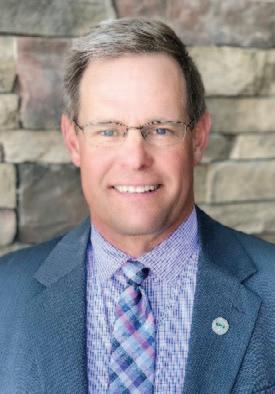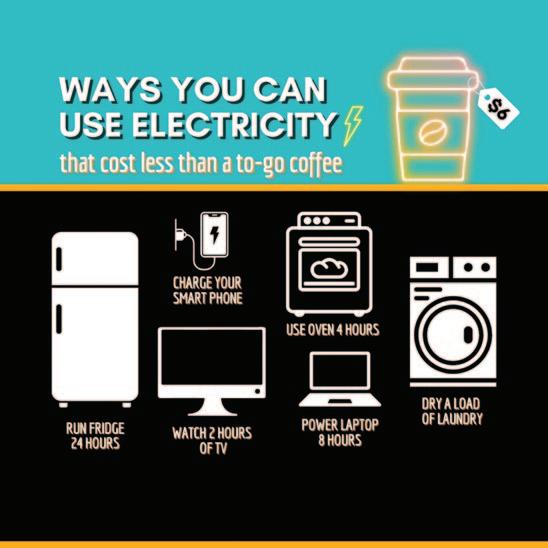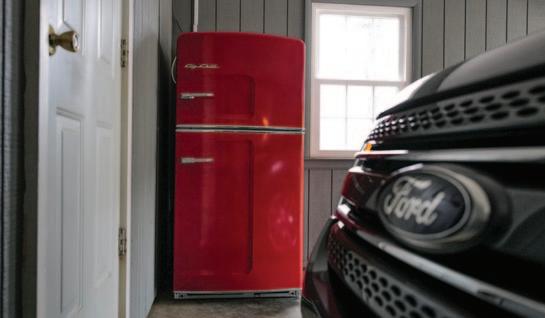




At Tri-State G&T, we believe in the strength of rural communities — and we’re working hard to protect them. Our vegetation management crews are out in the field year-round assessing vegetation risk, clearing brush, trimming trees, and creating defensible space around power lines. It’s all part of our wildfire mitigation strategy to keep your family, homes, and businesses safe. Because when it comes to wildfires, prevention is power.

WHATEVER THE FUTURE HOLDS, WE’LL POWER IT.®
Scan to learn more about our year-round wildfire mitigation program.
Tri-State is a not-for-profit power supplier to cooperatives and public power districts in Colorado, Nebraska, New Mexico and Wyoming.

Staff
General Manager
Rick Nelson
Editor
Wayne Price
Editorial Assistant Tina Schweitzer
President Greg Strehle, Cuming County Public Power District
Vice President/Secretary Vance McCoy Midwest Electric Cooperative Corporation
Treasurer Dan Scheer
Howard Greeley Rural Public Power District
Published monthly by the Nebraska Rural Electric Association, 1244 K Street, Box 82048, Lincoln, Nebraska 68501, (402) 475-4988.
Advertising in the Nebraska Magazine does not imply endorsement for products by the Nebraska Rural Electric Association. Correspondence should be sent to Wayne Price, Editor, Nebraska Magazine, Box 82048, Lincoln, NE 68501.
The Nebraska Magazine is printed by the Aradius Group, 4700 F Street, Omaha, NE 68117. Form 3579 should be sent to Nebraska Magazine, Box 82048, Lincoln, NE 68501.
Periodicals postage paid at Lincoln, Neb.
POSTMASTER: send address changes to Nebraska Magazine, 1244 K Street, Box 82048, Lincoln, NE 68501.
Publication numbers are USPS 071-630 and ISSN 01934937.
Subscriber Services: Cost of subscription for consumers of participating member-systems is $2.14 per year (17.8 cents per month), plus periodicals postage paid from equity accruing to the consumer. For nonmembers, a subscription is $10 per year or $20 for three years, plus local and state tax. Single copy, $2.50.


Electricity is something most of us do not think much about until the bill arrives. One of the most important ideas that affects how much it costs to deliver power is something called peak demand. It’s a concept that electric utilities use to make sure there is enough electricity available when people need it most.
As Nebraska continues to rely on electricity for nearly everything in our homes, schools, hospitals and businesses, we need it to be reliable and affordable. You can be assured, your local electric utility always puts you top of mind and works each day to ensure electricity remains the best value for your money.
ON THE COVER
Perched on a bloom of crabapple blossoms, a pair of Mourning Doves enjoy the warm Nebraska sunlight. This image highlights the quiet beauty of one of North America's most beloved backyard birds. Photograph by Michael Bazant

There isn’t much in our daily lives that doesn’t involve the use of electricity. From flipping on the lights, starting up the computer, cooking a meal, keeping food cold, watching our favorite show on television...it all requires reliable electricity. And every time we turn something else on it causes the electric meter outside to spin a bit faster and the monthly electric bill to climb a little higher.
Many of us ask the same question when the electric bill arrives: Is there a way to use less without giving up comfort or convenience? The good news is yes, and it starts with understanding two key ideas—energy conservation and energy efficiency
Visit our website at nebraskamagazine.org

Though they’re often used together, these terms mean slightly different things. Conservation is about cutting back on how much electricity we use. That might mean turning off lights when you leave a room, unplugging devices when they’re not in use, or using natural light during the day. Efficiency, on the other hand, means getting the same results while using less energy. Think LED light bulbs that last longer and use a fraction of the power, or newer appliances that work smarter instead of harder. Insulating your home properly is another great example. It keeps your house warmer in the winter and cooler in the summer without relying as heavily on heating or air conditioning.

If you’re not sure where to begin, a home energy audit is a great starting point. Many public power districts and electric cooperatives across Nebraska offer this service at no cost. An audit gives you a clear picture of where your home is using the most energy and offers practical, targeted suggestions to improve efficiency.
Even small changes—like sealing windows, switching to Energy Star-rated appliances, or adjusting your thermostat—can make a noticeable difference. And when many homes across a community take similar steps, it can lead to lower overall demand for electricity, which helps delay the need for expensive new power plants. That benefits both the environment and your wallet.
By making energy-saving habits part of everyday life, we all have a role to play in building a more efficient, sustainable future. Using electricity wisely does not mean using less of what we love—it means making sure every kilowatt does more for us, and for the generations to come.

Recent discussions about power shortages and blackouts may have some Nebraskans wondering if the Cornhusker State is at risk of running out of electricity. The short answer? No. Are capacity supplies getting tight? Yes, but not at unanticipated levels. Nebraska has a strong, diverse, and well-managed energy infrastructure, and there is no indication that the state is in danger of running short on power.
Nebraska's electric grid is both resilient and robust. As of 2023, the state maintained approximately 10,781 megawatts (MW) of summer capacity, comfortably supplying more electricity than it consumes. The generation portfolio is also diverse. Nebraska sources electricity from coal (43%), wind (32.5%), nuclear (16.2%), and natural gas (4.3%), with the remainder coming from hydro, solar, and biomass. This balanced approach helps mitigate risks associated with overreliance on any single energy source.
General Manager of Chimney Rock
Public Power District headquartered in Bayard, Neb.
Planning for Nebraska's energy future is not left to chance. In fact, it’s the exact opposite. Years of historical data go into the siting, sizing, fuel type, and routing of power plants, transmission line, and switchyard infrastructure. All generating utilities across the country are all in a building phase right now. Even Nebraska’s generating utilities are investing billions to prepare for the future. Fortunately, Nebraska is known nationally for its high reliability and affordable electricity. Investing more to expand that foundation will produce a handsome result for Nebraskan’s.
Utilities are also investing in modernization, including smart grid technologies and dual-fuel generation capabilities. About 17 percent of Nebraska's winter capacity can switch fuels, offering extra security during extreme weather events. Coal plants maintain on-site fuel reserves sufficient for more than a month of continuous operation, further insulating the system from supply chain disruptions. Furthermore, NPPD’S proposed generation buildout is comprised of all natural gas dispatchable generators. Those can be called on in any weather, or loading condition and they will perform.
Grid reliability in Nebraska is among the best in the nation. Outages are infrequent and generally brief. The state's public power model prioritizes affordability and service quality, consistently delivering some of the lowest electricity rates in the country.
Continued on Page 11

Electricity is something most of us do not think much about until the bill arrives. We flip a switch, plug in a charger or turn on the air conditioning without a second thought. But behind the scenes, delivering that electricity to your home or business takes planning, coordination and infrastructure. One of the most important ideas that affects how much it costs to deliver power is something called peak demand. It’s a concept that electric utilities use to make sure there is enough electricity available when people need it most.
Think of your electric use like water flowing through a pipe. The total amount you use over a month is important, but so is the maximum flow at any one time. That maximum flow is your peak demand. Suppose you want to fill a five-gallon bucket with water. You can use an inexpensive hose connection to your sink providing one gallon per minute to do it, and it will take five minutes. Or you can get to a more expensive large faucet that provides five gallons per minute, it will fill in just one minute. The flow rate is the equivalent to demand, and the five gallons of water are equivalent to consumption. In this example, filling both buckets has the same “consumption” but very different “demands.”
In electricity terms, it is the highest level of energy you use at one time during the billing period. For example, if your household is running the air conditioner, oven, clothes dryer and dishwasher all at once on a hot August afternoon, you are likely hitting your peak demand for the month.
Electric utilities have to build and maintain a system that can handle everyone’s peak demand, not just the average. That means having enough generating power plants, wires, substations and equipment in place to meet the highest possible need at any given moment. Those systems cost money whether they are being used fully or not, and that cost is passed on to all of us as ratepayers.

This is where peak demand rates come in. These rates are designed to encourage customers to use electricity more evenly throughout the day and to avoid using too many high-power appliances at the same time. By reducing peak demand, we can make better use of the infrastructure we already have, avoid building unnecessary new power plants and keep rates more affordable for everyone.
For consumers, the benefit is both immediate and longterm. When you lower your peak demand, your utility may reward you with a lower bill if you are on a rate plan that reflects demand charges. Many businesses already operate under these types of rates, and residential customers may begin seeing similar structures in the future. Even if your current rate is flat and does not charge you based on peak demand, reducing your use during high-demand hours helps your utility avoid higher


costs from its power supplier. That savings trickles down to all customers over time.
The other big benefit is reliability. On very hot or very cold days, when everyone is using heat or air conditioning at once, the grid is under the most stress. If too many people are demanding too much electricity at once, the risk of outages increases. When more people spread their usage out, the grid stays balanced and more dependable.
Fortunately, managing peak demand is something every customer can help with. You might shift your laundry and dishwashing to the evening, turn up the thermostat a few degrees during the hottest part of the day or use smart home devices to stagger when things turn on. These small changes may not seem like much, but when hundreds of people participate, the results are significant.

Currently in Nebraska some of the public power districts and electric cooperatives have a peak demand charge demand on large industrial and commercial customers. But demand charges to all rate classes, including residential rates, are expected in the future as electric demands increase across the state.
If you own an electric vehicle, charging during off-peak hours may mean taking advantage of reduced electricity rates or incentives, helping you save money compared to charging during peak demand times. Smart scheduling means more affordable EV ownership and better energy budgeting.
This practice not only enhances the appeal of EVs but also aligns with the public power values of reliability, sustainability and affordability, helping build a smarter and more efficient energy system for future generations.
The idea behind peak demand rates is about fairness and efficiency. It ensures that those who place the greatest strain on the system contribute a little more toward its cost, while rewarding those who help ease the load.

Data centers are the backbone of the internet. They store and manage everything from social media to cloud computing, AI and our favorite streaming services. As more people and businesses go digital, the number of data centers is quickly growing. While many of these centers were once built near large cities, more are now being sited in rural areas.
Public power districts and electric cooperatives are receiving regular requests from companies that seek to build large data centers in their service territories. These requests bring both big opportunities and major challenges.
Why are data centers coming to rural areas? There are several reasons why companies are choosing rural locations for their data centers:
• More land. Rural areas have plenty of space for large buildings.
• Resource diversity. Public power districts and electric cooperatives own and operate reliable sources of energy.
• Lower costs. Land and labor are usually less expensive outside of cities.
• Tax breaks. Local and state governments may offer tax benefits to attract these businesses.
By Allison Hamilton
Data centers can be huge, sometimes requiring more electricity than all the utility’s members combined. This increased demand for electricity brings several new

opportunities for public power districts and electric cooperatives.
• Stable revenue. These centers require a lot of power and usually sign long-term contracts. This provides the local electric utility with steady income, which can help pay for system upgrades and keep rates lower for other members in the community.
• Improved infrastructure. To serve a large data center, the utility might need to build new power lines or substations. While this is expensive, it can also improve service for all utility consumers by making the electric system stronger and more reliable.
While data centers create significant opportunities for rural electric utilities by driving demand and investment, they also present new challenges in meeting increased electricity needs while maintaining reliable and resilient power delivery.
• High upfront costs. Building the new infrastructure to power a data center can cost millions, which is why local electric utilities work diligently with data center customers to ensure upfront costs are covered.
• Risk of losing a big customer. If the data center moves away or shuts down, the local electric utility could be left with expensive equipment it no longer needs. This could negatively impact the utility’s finances.
• Permitting and siting. Acquiring permission to
Data centers can be huge, sometimes requiring more electricity than all the utilitys members combined. This increased demand for electricity brings new opportunities and challenges for public power districts and electric cooperatives. Photograph by Brett Sayles
build new power lines and substations takes time. There may be zoning rules, environmental reviews and public meetings that slow things down.
To manage both the risks and rewards that data centers bring, electric utility leaders are taking a careful, informed approach. They are working closely with their generation and transmission provider (G&T), economic development offices and financial experts to plan these projects.
Public power districts and electric cooperatives are also ensuring contracts with data center operators include protections for the utility. For example, if the data center leaves early, they may be liable for paying part of the infrastructure costs. Forecasting tools are also aiding utilities in understanding how the new load will impact the local system.
Serving large data centers could be a gamechanger for many public power districts and electric cooperatives. These projects can bring jobs, revenue and new technology to rural electric utility communities. But they also come with financial risks and planning challenges. By asking the right questions and building smart partnerships, public power districts and electric cooperatives are poised to make decisions that serve their consumers well—now and in the future.

School buses are among the safest vehicles on the road — but the greatest risk comes when children are getting on or off the bus. Whether you’re a driver, parent or student, knowing these safety tips will help keep everyone safe.
• Slow down: Reduce speed in school zones and near bus stops. Watch for children walking in the street, especially if there are no sidewalks in neighborhood.
• Keep your distance: Stay back at least 10 feet from a school bus — this is the most dangerous area for children.
• Know the signals:
• Yellow flashing lights: bus is preparing to stop — slow down.
• Red flashing lights + stop arm: bus is loading/unloading — stop and wait until the bus moves again.
• Never pass a stopped bus on an undivided road — it’s illegal in most states.
• Stay alert: Watch for kids who may unexpectedly enter the road, especially near bus stops. When backing out of a driveway or leaving a garage, watch out for children walking or bicycling to school.
• Respect the zone: When flashers are blinking in a school zone, stop for pedestrians at crosswalks and take extra care to look for children near playgrounds, parks and residential areas.
The greatest risk to your child is not riding a bus, but approaching or leaving one. Before your child goes back to school or starts school for the first time, it’s important for you and your child to know traffic safety rules. Teach your child to follow these practices to make school bus transportation safer. Teach your child to arrive at the bus stop at least five minutes early, and how to play it SAFE:
• Stay at least ten feet — five giant steps — from the curb. Remind your child that the bus stop is not a place to run or play.
• Always wait for the bus to stop and the driver to signal before boarding. Your child should use the handrails to avoid falling.
• Face forward and buckle up if seat belts are available.
• Exit carefully, look both ways and cross in front of the bus — never behind. Make eye contact with the driver before crossing.
• If your child drops something near the school bus, like a hat or book, the safest thing is for your child to tell the bus driver right away. Your child should not try to pick up the item, because the driver might not be able to see him/her.
With increased economic development — including new data centers, advanced manufacturing, and agriculture — demand is expected to grow. Bottom line, low rates and high reliability are good for business because the more users of our public power system equal better utilization, and better utilization means lower and more stable rates for all.
Nebraska is not facing a power shortage. It has a diverse and growing energy portfolio, a reliable grid, and comprehensive planning processes in place. By continuing to invest in infrastructure and embrace innovation, Nebraska is wellpositioned to meet current and future energy needs.
Rather than fearing an energy shortfall, Nebraskans can take pride in the strength and foresight of their public power system that is and always has been run for Nebraskan’s, by Nebraskan’s. The state isn’t running out of power—it’s preparing to power the future.

When Mom moved to town she missed getting Nebraska Magazine so I bought her a subscription. It only cost $10 plus tax. Call 402-475-4988 to get your subscription started today.


He came for me as he said he would, pulling me into the circle for the dance. All I had to do was step out, bravely, to experience something old. And something new.
We glided beside a stately, grey-haired woman, a regal fan of feathers in her hand, her feet encased in soft deer hide. We danced behind little girls in jingle dresses, the silver bells reminiscent of the lids of chewing tobacco, once rolled into cones and sewn onto the dresses of ancestral women. We fell in step with the traditional dancer, the chicken dancer, the fancy shawl dancer. This circle was part of a powwow, a celebration of the American Indian culture, as packed full of songs, dance and honor as beadwork on a moccasin. We danced in a circle because straight lines exorcise and exclude, while circles entice us into an ever-widening ring: Omaha, Ponca, Winnebago, Santee Sioux, and even someone like me.
You see, the ancestral tradition handed down in my family was that my great-great-grandmother was an American Indian, emigrating to Nebraska from her tribal
home in Wisconsin. Consequently, I studied the tribes of Wisconsin, hung a dream catcher above my bed fashioned from birch wood, and finally, sent off my DNA. It was there, through Ancestry.com, that I learned my blood runs red, but not Indian red. The tale was only a well-loved fable, which made me a hope-filled imposter in Wisconsin’s Menominee Tribe, Bad River Band, the Lac du Flambeau or St. Croix Chippewa.
Some of those who danced beside me wore the regalia, or attire, of their ancestors.
Costumes, I learned, like those worn at Halloween, make you who you aren’t. Regalia makes you who you are. So, I danced—in the regalia of my plain shirt and jeans—the descendant of German immigrants and an imaginary Indian grandmother. But mostly I danced in recognition of the similarities between myself and the man dancing beside me. For starters, both of us grew up on the Plains, as native and perennial as rustling cottonwoods.

It was a beginning, a good beginning, and from there, we could branch out, he and I. He could tell me the history of our shared country’s original inhabitants, those who greeted pale-skinned sailors from three ships landing on eastern shores, thinking they had reached Asia; I could tell him how my great-grandfather, centuries later, took his first steps on a boat bound for America. I could revel in the drumbeat of the tribal dance; he could rejoice in the oom-pah-pah of the Polka. I could share my grandmother’s warm apple kuchen; he could split a piece of his fry bread. I could say to him Guten tag; he could reply A-ho.
After all, it takes only one brave step to experience something old. And something new.
This is LaRayne Topp, just roaming the countryside.



















Minimum order of 5 coins
GENERATIONAL WEALTH is of paramount significance as it represents a beacon of financial stability. It serves as a tangibletestament to the hard work, diligence, and financial acumen of previous generations, offering a solid foundation upon which future generations can build their dreams and aspirations.
American Gold Reserve is releasing Government issued $5 Gold American Eagles completely free of dealer mark-up for only $349 each. These beautiful $5 Gold American Eagles are a perfect way to enter the gold market. They are set for immediate public release and will sell out fast.

• Free of dealer markup. • Protection against inflation and deflation. • Gold offers financial cover during geopolitical uncertainty. • Good portfolio diversifier.

If you’re like me, there are aspects of your life that become sort of a daily routine. I get ready for work, get in my car and drive to the coffee shop on the way to the office. At lunchtime, I drive to the nearest fast-food location and get lunch. Once I finally end the day at home, I stream an episode or two of my favorite show before bed.
As we all look for ways to save money in this age of increasing inflation, I began to think about my daily routine and how much value it provided me compared to the money I spent. A morning latte was costing me about $6, a fast-food combo with a burger, fries and a drink was setting me back $10, and my Netflix subscription is about $16 each month. All these daily expenses totaled around $85 a week, or about $340 monthly. And what was the real value—short-term satisfaction and a larger
waistline? Even as I started packing my own lunch, my latte was still costing me about $120 a month. This got me thinking—is this the best value for my money?
The average daily cost of electricity is about $4.57, and the average monthly electric bill for Nebraskans is $140. You could power your entire home every day for the price of a medium latte. I could brew my own coffee, cook my own meals, binge a series and run on a treadmill for less than the cost of that drink. Now to me, that’s real value.
Electricity provides benefits that we often take for granted. It goes well beyond short-term satisfaction by allowing us to charge devices and have cold food and hot water, all in a comfortable indoor climate. Besides the privilege it affords, electricity has also remained relatively cost-stable even amidst rising inflation.

Your public power district or electric cooperative does everything in their power to ensure your costs stay reasonable and that electricity remains a great value for our members. It’s not always easy, as there are several factors beyond inflation that impact the price of electricity—some within our control but most beyond it.
The cost of electricity can fluctuate due to supply and demand, infrastructure investment, maintenance and operational expenses. Weather patterns also contribute, affecting both demand and generation capabilities, with extreme conditions leading to heightened energy use or disruptions. Government policies, such as subsidies for renewable energy or taxes and regulations on emissions, shape electricity costs as well. Your electric utility considers all these aspects when adjusting rates, and because we’re public power, we consider the impact of those costs on our consumers as well.
As Nebraska continues to rely on electricity for nearly everything in our homes, schools, hospitals and businesses, we need it to be reliable and affordable. You can be assured, your local electric utility always puts you top of mind and works each day to ensure electricity remains the best value for your money.


When it comes to value, electricity is a clear winner, and we’re always looking for ways to work with you to make it even better. That’s why your local electric utility urges energy efficiency, encourages you to look for ENERGY STAR® appliances, and promotes technology, designed to give members more control over their electricity use.
Energy performance dashboards, smart thermostats and power strips, and appliance settings that shift most water heating, laundry and dishwashing outside of peak rate periods help reduce the utility’s overall power demand. They also give you opportunities to control or even trim your monthly utility bills.
That’s good for families, couples and individuals trying to live within their budgets. And it’s going to become even more important as digital devices and internet-connected technologies become even more important in our lives.
Grilling outdoors is not only a good way to keep your house cooler and lower your energy bill, it’s a great way to enjoy warm summer days with family and friends. Grill safe with these simple tips:
Location matters:
• Place grills on a stable, flat surface.
• Keep away from homes, decks and branches.
• Grill outdoors only — never inside garages or enclosed spaces.
• Keep kids and pets at least 3 feet away.
• Never leave the grill unattended.
For gas grills:
• Check for gas leaks before each season.
• Open the lid before lighting to prevent gas buildup.
• Turn off gas if the flame goes out; wait five minutes before relighting.
For charcoal grills:
• Only use charcoal starter fluid.
• Never add lighter fluid to a lit fire.
• Let coals cool after use, then dispose in a metal container.
For electric grills:
• Use outdoor-rated grills when cooking outside.
• Never grill in rainy or wet areas.
• Plug into a GFCI outlet for shock protection.
• Check cords for damage before use.
Dirty grills are a leading cause of grill fires, according to the National Fire Protection Association (NFPA). Despite the belief that a seasoned grill enhances flavor, regular cleaning is essential for safety and performance:
Cleaning & maintenance:
• Clean grease buildup to prevent fires.
• Follow manufacturer’s instructions.
• A clean grill = fewer fires + better flavor.
Each year, grill fires cause thousands of injuries and millions of dollars in property loss, according to the NFPA. Most grill fires can be prevented with proper maintenance and safe use.


The Southwest Nebraska Public Health Department (SWNPHD) is raising the alarm after three cases of tularemia were reported in the health district over the past month—a sudden spike for a disease that is typically quite rare. “Only six cases of tularemia were reported to us over the past ten years,” said Melissa Propp, RN, Clinic Manager at SWNPHD. “So getting three in one month is unusual. We encourage everyone to take extra precautions to avoid tick bites.”
Tularemia is a potentially serious disease caused by a bacterium called Francisella tularensis. It’s most commonly spread by tick or deer fly bites, or by handling infected wild animals, especially rabbits and rodents. While treatable with antibiotics, tularemia can be life-threatening if left untreated.
Symptoms often begin suddenly and may include fever, chills, headache, swollen lymph nodes—especially in the armpit or groin—and a skin ulcer at the site of the bite. Because these symptoms can resemble other illnesses, it’s important to let your healthcare provider know if you have had recent exposure to ticks or wild animals.
The best way to protect yourself from tularemia is to take steps to prevent tick bites and avoid close contact with wild animals. Here are a few key safety tips:
You may get different illnesses depending on the type of tick and where it lives. The Nebraska Department of Health and Human Services (DHHS) released information in May through the Health Alert Network (HAN) about all the tick-borne diseases that are in Nebraska, including tularemia. The HAN is used for sharing important and timely information about public health, and can be found at dhhs.ne.gov/HAN.
More information on tularemia may be found at cdc.gov/tularemia or contact SWNPHD at 308-345-4223.

• Use insect repellent. Choose a bug spray that contains DEET or another EPA-approved ingredient for tick prevention.
• Treat your gear. Spray tents, clothing and camping equipment with Permethrin, which repels and kills ticks on contact.
• Keep your distance. Avoid handling wild rabbits and rodents. If you must handle wildlife, wear gloves and wash your hands thoroughly afterward.
• Be careful with tick removal. If you find a tick on your skin, remove it carefully by grasping it close to the skin with tweezers and pulling straight out. Avoid twisting, squeezing, or using creams or chemicals, which can increase the chance of infection.
After removing a tick, clean the area with soap and water. Dispose of the tick by flushing it or sealing it in tape and throwing it away. And if you develop a fever or other symptoms within a few days of a bite, don’t wait— contact your doctor.
Tick-borne illnesses are a growing concern in Nebraska and beyond. By being aware of the risks and taking simple precautions, you can enjoy the outdoors safely this summer.
by Miranda Boutelle
When exploring ways to be more efficient with refrigerators and freezers, we often find ourselves stuck between convenience and conserving energy. While you can upgrade to newer equipment, care and equipment habits can be just as important to saving energy.
Here is some guidance on equipment energy use, including tips to keep your current equipment running efficiently and ways to limit overuse of refrigeration in our homes.
The U.S. Department of Energy helps us understand what to look for in our existing equipment and new appliances. In general, the larger the refrigerator, the more energy it uses. The most efficient models are typically 16 to 20 cubic feet. Models with the freezer on top tend to use less energy than bottom freezers or side-by-side units. A refrigerator 15 years or older uses about 35% more energy than an Energy Star-certified model.
Let’s explore some tips to keep your refrigerator running efficiently.
Keep it organized. One of the biggest issues with refrigerator energy use is opening the door or keeping it open. An organized fridge makes food items easier to find, minimizing open-door time and keeping cold air inside. Place items in the same spots so they are easier and faster to find. I tell my kids to take a quick look inside at the options and close the door while they are deciding what to eat.
Keep it clean. Regularly cleaning the gasket—the flexible strip around the perimeter of the fridge door— ensures a tight seal between the door and the unit to keep cold air inside. If the gasket is not sealing tightly, it should be replaced. Removing and cleaning the vent at the bottom of the unit can help airflow. For the coils at the back, use an extended cleaning brush instead of moving the fridge and risking injury.
Also, keep food safety in mind. The Department of Energy recommends setting your refrigerator temperature between 35 and 38 degrees and freezer at 0 degrees. If you have a second refrigerator or freezer, here are some things to consider that can help you save energy. Do you need it plugged in year-round? Perhaps you can keep it empty and unplugged for part of the year. Maybe


Top: Clean the vent cover and remove dust and debris buildup in the vent area under the front of the refrigerator. If you have a second refrigerator or freezer, consider ways to avoid food waste and unplug the extra appliance when it is not needed.
Photographs by Mark Gilliland, Pioneer Utility Resources
you only really need it during the holiday season. Unplugging it for the months you aren’t using it will save energy, and you’ll still have it as a backup when you need it.
If you are a hunter or buy meat in bulk, set a goal to empty out your freezer before you restock. This allows you to avoid food waste and unplug the extra appliance when it is not needed.
If possible, consider the location. Keeping the second fridge or freezer in a cool basement versus a hot garage requires less energy.
Instilling simple cleaning and food storage habits are easy ways to be more efficient with your in-home refrigeration.

Electrical safety is crucial for everyone, but especially important for seniors. Adults over the age of 65 are at the greatest risk of death from fire and this risk increases with age, according to the National Fire Protection Association. As we age, our reflexes slow down, eyesight decreases and senses become less acute, making it essential to take extra precautions when handling electrical appliances.
Here are some ways for older adults to maintain a safe living environment:
1.
Ensure that electrical appliances are in good working condition. Regularly inspect cords and plugs for damage or wear and tear.
Don't overload sockets or extension cords. Plugging too many appliances or devices into a single outlet can cause overheating and increase fire risk.
Limit the use of carpets and rugs, which are tripping hazards, and avoid placing extension cords under them to prevent overheating. To help prevent trips and falls, cords should not stretch across a room. For a safer and more permanent solution, consider having an electrician install additional outlets where needed.
Unplug appliances when not in use and before cleaning or repairing them.
Install ground fault circuit interrupters (GFCIs),
2. 3. 4. 5. 6. 7. 8. 9.
which are designed to prevent electric shock by shutting off power when a ground fault is detected. Install them in areas where water and electricity are in close proximity, such as kitchens, bathrooms and outdoor spaces.
Keep electrical appliances away from water and wet surfaces to prevent electric shock.
Ensure proper lighting in all areas of the home, especially in hallways and staircases, to prevent trips and falls. Consider installing nightlights in bedrooms and bathrooms for better visibility.
Set hot water heaters to lower settings to prevent scalding.
When cooking on the stove, never leave pots and pans unattended, and avoid wearing loose clothing when cooking. Never open the oven door


if something catches fire inside the oven. Consider using toaster ovens and small appliances that come equipped with an auto shut-off feature for added safety and convenience. This feature is designed to turn off the appliance automatically after a set amount of time or when a task is completed, reducing the risk of overheating or fire.
Use space heaters with caution. Space heaters can offer added warmth to a senior, who may get cold due to circulation issues that are common with aging. Use space heaters with built-in safety features such as an automatic shut-off switch. Keep space heaters on a steady surface and at least three feet away from flammable objects such as curtains, bedding or furniture. Plug them directly into an outlet — do not use an extension cord or power strip — and unplug them when not in use.
10. 11.
Install smoke detectors on every floor and carbon monoxide detectors near all bedrooms. Test and replace the batteries twice a year.
By following these safety measures, seniors can significantly reduce their risk of electrical accidents. Family members and caregivers can assist older adults in implementing these precautions to ensure their homes are safe and comfortable.
It’s easy to get into a recipe rut when every day feels the same –work, kids’ activities, social events and bedtime routines make it tough to experiment in the kitchen. If your family’s meals are growing boring, all you need is a touch of heat to bring new life to the menu.
With just the right balance of heat and honey, they add delicious sizzle and mouthwatering flavor to recipes like Hot Honey Chicken Meatball Subs. Perfectly toasted hoagie rolls are packed with spicy, sweet chicken meatballs and smothered in melted provolone for a tough-to-top taste. Ready in 35 minutes, the subs offer a blend of convenience and gourmet flavor, making this meal an unbeatable choice at dinner time.
Solve afternoon hunger pangs with these Hot Honey Chicken Rice Crackers and Ranch Dip, loaded with the sweet heat of hot honey chicken and baked to crispy perfection. This inventive snack is uniquely crunchy and flavorful, blending fiery sweetness with savory chicken flavor as a convenient way to shake up snack time.
Discover more ways to shake up mealtimes by visiting www.MinuteRice.com.

1 Minute Hot Honey Chicken Seasoned Rice Cup
1 pound ground chicken
1 teaspoon salt
1 teaspoon cayenne pepper (optional)
1/4 cup breadcrumbs
4 hoagie rolls
2 tablespoons butter
4 slices provolone cheese garlic sauce, for garnish
Preheat oven to 375 F. Heat rice according to package directions. In large bowl, mix rice; chicken; salt; cayenne, if desired; and breadcrumbs.
Use cookie scoop or hand roll chicken mixture into balls. Place on aluminum foil-lined sheet tray, leaving small space between each
ball. Bake 25 minutes, flipping meatballs halfway through.
Slice hoagies in half, lengthwise. Remove some bread from middle to make room for meatballs. Butter inside of each hoagie and place on sheet tray.
Once meatballs are cooked through, turn broiler on high and place buttered hoagies in oven. Cook 1 minute, or until butter is melted and hoagie has browned. Remove hoagies from oven, place 3-4 meatballs inside (depending on size) and cover with slice of cheese. Broil on high 30 seconds to melt cheese.
Drizzle garlic sauce on top.

1 Minute Hot Honey Chicken
Seasoned Rice Cup
1 cup sour cream
1/2 packet ranch dip seasoning
Preheat oven to 400 F. Heat rice according to package directions. Lay rice on parchment paper. Place another sheet of parchment paper on top. Use rolling pin to roll out rice into thin layer.
Bake 20 minutes.
In medium bowl, mix sour cream and ranch seasoning.
Once crackers are cooked, cut into squares while still hot. Allow to cool.
Serve crackers with ranch dip.
Tip: Ranch dip can be substituted with hummus or any flavored dip.
1 stick of margarine
1 cup of flour
1/2 cup chopped pecans
1 8 oz. package of cream cheese, softened
3/4 cup powdered sugar
1 cup whipped topping
2 regular size packages of instant lemon pudding mix
2 3/4 cups of milk
Combine margarine, flour and chopped pecans and pat into the bottom of a 9” X 13” pan. Bake at 350 degrees for 15 minutes for a metal pan and 325 degrees for 15 minutes if using a glass pan. Allow to cool. Beat cream cheese and sugar. Fold in whipped topping. Let set for 15 minutes before spreading on cooled first layer. Beat together the pudding mix and milk. Pour over cream cheese layer. Top with additional whipped topping if desired. Chill.
Darlus McWilliams, Norfolk, Nebraska
Eggplant Bake
1 large (or more) eggplant, peeled and sliced
1 egg, beaten Italian breadcrumbs
1 quart Ragu spaghetti sauce
1 lb. mozzarella cheese, grated Oregano Parmesan cheese
Dip eggplant slices in egg and breadcrumbs, then fry until golden brown. In a 9” X 13” pan make layers of the spaghetti sauce, eggplant slices, and mozzarella cheese. Sprinkle top with oregano and parmesan cheese. Bake at 350 degrees for 45 minutes.
Jenny Bergt, Amherst, Nebraska
2 tablespoons olive oil
1 teaspoon cumin
2 large onions, finely chopped
2 garlic cloves, minced
2 carrots, scraped and chopped
1 jalapeno pepper, seeded and finely chopped
1 28 oz can tomatoes,
undrained (can use fresh if available)
1 1/2 cups frozen corn
3 medium zucchinis, diced
8 oz. penne pasta, cooked al dente
1 6 oz. can red kidney beans, rinsed and drained
4 oz. sharp cheddar cheese, shredded
In a large nonstick skillet, heat olive oil. Add cumin, onion, garlic and sauté until the onion is soft and translucent. Add the carrots, jalapeno and tomatoes with juice and heat to a boil. Reduce heat and simmer uncovered for 15 minutes. Add the corn and zucchini and simmer for 5 more minutes. Add the cooked pasta and kidney beans and mix well. Pour the mixture into a 4-quart casserole, add cheese on top and place in a 350 degree oven for about 5 minutes or until cheese is melted.
Janice Hitz, Norfolk, Nebraska























